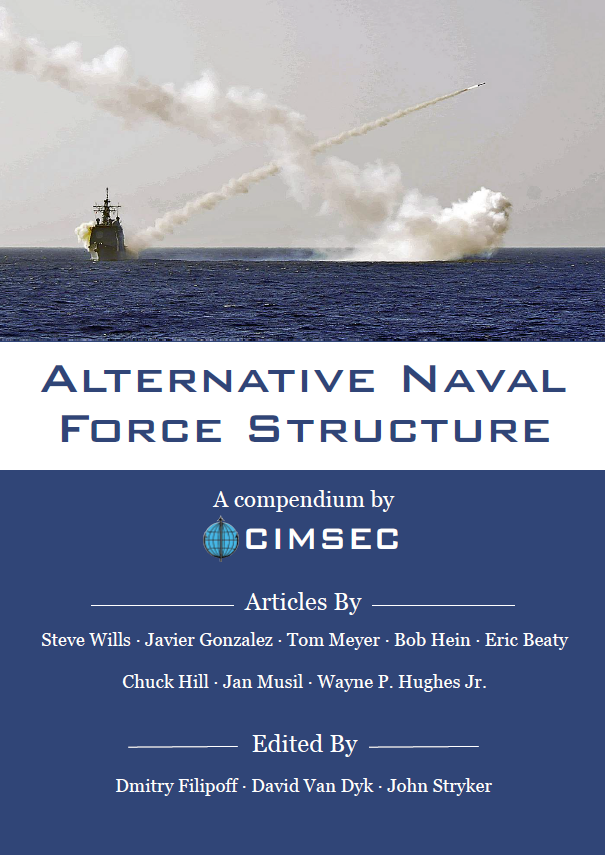By Dmitry Filipoff
From October 3 to October 7, 2016 CIMSEC ran a topic week where contributors proposed alternative naval force structures to spur thinking on how the threat environment is evolving, what opportunities for enhancing capability can be seized, and how navies should adapt accordingly. Contributors had the option to write about any nation’s navy across a variety of political contexts, budgetary environments, and time frames.
Relevant questions include asking what is the right mix of platforms for a next-generation fleet, how should those platforms be employed together, and why will their capabilities endure? All of these decisions reflect a budgetary context that involves competing demands and where strategic imperatives are reflected in the warships a nation builds. These decisions guide the evolution of navies.
In a modern age defined by rapid change and proliferation, we must ask whether choices made decades ago about the structure of fleets remain credible in today’s environment. Navies will be especially challenged to remain relevant in such an unpredictable era. A system where an average of ten years of development precedes the construction of a lead vessel, where ships are expected to serve for decades, and where classes of vessels are expected to serve through most of a century is more challenged than ever before.
Authors:
Steve Wills
Javier Gonzalez
Tom Meyer
Bob Hein
Eric Beaty
Chuck Hill
Jan Musil
Wayne P. Hughes Jr.
Editors:
Dmitry Filipoff
David Van Dyk
John Stryker
Articles:
The Perils of Alternative Force Structure by Steve Wills
“Even the best alternative force structure that meets strategic needs, is more affordable than previous capabilities, and outguns the enemy could be subject to obsolescence before most of its units are launched. These case studies in alternative force structure suggest that such efforts are often less than successful in application.”
Unmanned-Centric Force Structure by Javier Gonzalez
“The conundrum and implied assumption, with this or similar future force structure analyses, is that the Navy must have at least a vague understanding of an uncertain future. However, there is a better way to build a superior and more capable fleet—by continuing to build manned ships based on current and available capabilities while also fully embracing optionality (aka flexibility and adaptability) in unmanned systems.”
Proposing A Modern High Speed Transport – The Long Range Patrol Vessel by Tom Meyer
Is the U.S. Navy moving from an era of exceptional “ships of the line” – including LHA’s & LPD’s, FFG’s, CG’s, DDG’s, SSN’s and CVN’s – to one filled with USV’s, UAV’s, LCS’s, CV’s, SSK’s and perhaps something new – Long Range Patrol Vessels (LRPV’s)? But what in the world is an LRPV? The LRPV represents the 21stcentury version of the WWII APD – High Speed Transports.
No Time To Spare: Drawing on History to Inspire Capability Innovation in Today’s Navy by Bob Hein
“Designing and building new naval platforms takes time we don’t have, and there is still abundant opportunity to make the most of existing force structure. Fortunately for the Navy, histories of previous wars are a good guide for future action.”
Enhancing Existing Force Structure by Optimizing Maritime Service Specialization by Eric Beaty
“Luckily, the United States has three maritime services—the Navy, Coast Guard, and Marine Corps—with different core competencies covering a broad range of naval missions. Current investments in force structure can be maximized by focusing the maritime services on their preferred missions.”
Augment Naval Force Structure By Upgunning The Coast Guard by Chuck Hill
“The Navy should consider investing high-end warfighting capability in the Coast Guard to augment existing force structure and provide a force multiplier in times of conflict. A more capable Coast Guard will also be better able to defend the nation from asymmetrical threats.”
A Fleet Plan for 2045: The Navy the U.S. Ought to be Building by Jan Musil
“2045 is a useful target date, as there will be very few of our Cold War era ships left by then, therefore that fleet will reflect what we are building today and will build in the future. This article proposes several new ship designs and highlights enduring challenges posed by the threat environment.”
Closing Remarks on Changing Naval Force Structure by CAPT Wayne P. Hughes Jr., USN (Ret.)
“The biggest deficiencies in reformulating the U. S. Navy’s force structure are (1) a failure to take the shrinking defense budget into account which (2) allows every critic or proponent to be like the blind men who formulated their description of an elephant by touching only his trunk, tail, leg, or tusk. To get an appreciation of the size of the problem you have to describe the whole beast, and what is even harder, to get him to change direction by hitting him over the head repeatedly.”
Dmitry Filipoff is CIMSEC’s Director of Online Content. Contact him at Nextwar@cimsec.org.
Featured Image: PACIFIC OCEAN (Oct. 27, 2017) Ships from the Theodore Roosevelt Carrier Strike Group participate in a replenishment-at-sea with the USNS Guadalupe (hull number). (U.S. Navy photo by Mass Communication Specialist Seaman Morgan K. Nall/Released)


